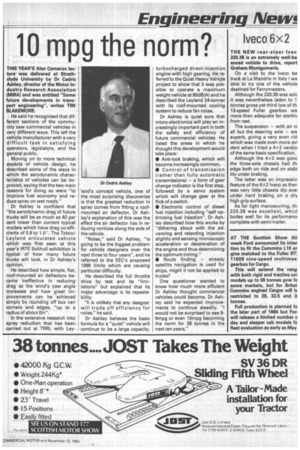10 mpg the norm?
Page 19

If you've noticed an error in this article please click here to report it so we can fix it.
THIS YEAR'S Alex Cameron lecture was delivered at Strathclyde University by Dr Cedric Ashley, director of the Motor Industry Research Association (MIRA) and was entitled "Some future developments in transport engineering", writes TIM BLAKEMORE.
He said he recognised that different sections of the community saw commercial vehicles in very different ways. This left the vehicle manufacturer with a very difficult task in satisfying operators, legislators, and the general public.
Moving on to more technical aspects of vehicle design, he described some of the ways in which the aerodynamic characteristics of vehicles can be improved, saying that the two main reasons for doing so were "to improve fuel economy and reduce spray on wet roads."
Dr Ashley is confident that "the aerodynamic drag of future trucks will be as much as 40 per cent lower than current typical models which have drag co-efficients of 0.8 to 1.0". The Tebco/ Leyland articulated vehicle which was first seen at this year's IRTE Solihull exhibition is typical of how many future trucks will look, in Dr Ashley's opinion.
He described how simple, flat, roof-mounted air deflectors became ineffective in reducing drag as the wind's yaw angle increases and how great improvements can be achieved simply by rounding off box van corners and edges, "up to a radius of about 6in".
In the extensive research into spray reduction that has been carried out at TRRL with Ley land's concept vehicle, one of the most surprising discoveries is that the greatest reduction in spray comes from fitting a roofmounted air deflector. Dr Ashley's explanation of this was the effect the air deflector has in reducing vortices along the side of the vehicle.
"Noise," said Dr Ashley, "is going to be the biggest problem for vehicle designers over the next three to four years", and he referred to the EEC's proposed 1986 limits which are causing particular difficulty.
He described the full throttle drive by test and its "limitations" but explained that its major advantage is its repeatability.
"It is unlikely that any designer will trade off efficiency for noise," he said.
Dr Ashley believes the basic formula for a "quiet" vehicle will continue to be a large capacity, turbocharged direct-injection engine with high gearing. He referred to the Quiet Heavy Vehicle project to show that it was possible to operate a maximum weight vehicle at 80dB(A) and he described the Leyland 24-tonner with its roof-mounted cooling system to reduce fan noise.
Dr Ashley is quiet sure that micro-electronics will play an increasingly important part in both the safety and efficiency of future commercial vehicles. He listed the areas in which he thought this development would take place: • Anti-lock braking, which will become increasingly common, • Control of transmission (rather than fully automatic transmissions) — a form of gear change indicator is the first step, followed by a servo system which will change gear at the flick of a switch.
• Electronic control of diesel fuel injection including "self optimising fuel injection". Dr Ashley described how this works by "dithering about with the advancing and retarding injection slightly and sensing microscopic acceleration or deceleration of the engine and thus determining the optimum timing." • Route finding — already satellite navigation is used for ships, might it not be applied to trucks?
One questioner wanted to know how much more efficient Dr Ashley thought commercial vehicles could become. Dr Ashley said he expected improvements to continue steadily. "I would not be surprised to see 89mpg or even 10mpg becoming the norm for 38 tonnes in the next ten years."








































































































































































